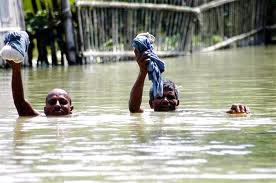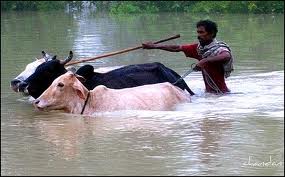
The second edition of the book came out in 2008 just after the devastating Bihar floods in the year when the river thundered down from the Himalayas on its way to the sea sweeping half of Bihar.
The book analyzes the behavior of rivers in northern Bihar, their impact on society, floods and their management. It argues against technical choices, as not feasible and stresses on living with rivers without building embankments. Joya Mitra, the translator notes in the preface that there is a need to live with floods, a message which comes across sharply in the book.
The Kosi river lived up to its reference as Bihar's 'river of sorrow' in the year 2008 by going back to a course it once followed many years ago and in the process inundated croplands and rendered nearly three million people homeless. The book refers to the desolate waterscape of flood-devastated Bihar and examines the causes behind the same.
The river's unstable nature has been attributed to the heavy silt it carries during the monsoon season. This meandering river is 20,000 years old and its seven currents cannot be tamed. The flood plains are elevated at the north along the Himalayas and slightly lifted in the east owing to silt deposition in flood plains. The river is prone to channel migration and it is believed that in the past 200 years, the river has shifted about 120 km because its original flow is eastward, before it merges with the Ganges.
According to the author, floods are never sudden and yet on its arrival we consider it as unexpected. A closer analysis of the present flood and flood-related events suggests that floods can be anticipated with reasonable accuracy yet people fail as regards preparedness thereby magnifying its destructive impact.

Floods in Kosi river in Bihar
Image courtesy: drdivas.wordpress.com
The book argues against engineering solutions in particular the attempts in the last two hundred years to jacket the river with embankments and barrages and notes that this may lead to more devastation. The devastating floods river Kosi wreaked upon millions of people has ignited public debate on the necessity of embankment as they do not work because the river carries high amounts of silt. Usually these are designed without a proper understanding of the morphology of the river.
Enclosing the silt-laden river within an embankment that will force it to run in east-west course against the region's topography is a recipe for future disaster. More so because the river arises in the fragile Central Himalayas, the Siwaliks whose conditions cannot be compared with either the North Eastern or the Western Himalayas. Kosi emerges from the young mountains whose activities are unpredictable and is prone to having silt and rocks being carried off with the water. The book traces how embankments that were meant to mitigate floods have been reduced to structures over which people can take refuge during floods.
The author suggests that for relief works the government should have instead of spending over twenty four crore rupees on helicopters and fuel for dropping food packets, which anyway turns out to be inadequate for flood relief, used over twenty thousand boats owned by the locals prior to and during the floods. This way flood management would have proven to be more efficient and cost effective.

Embankment along Kosi river in Bihar
Image courtesy: wespeaknews.com
Also, the locals are familiar with the meandering waters, big or small, and with their collaboration, the impact of floods can be less destructive. People in this part of the country knew to live with floods. They did not try to hold the rivers in check but wove around them a life of boats, fisheries and appropriate crops. Reductionist assumptions and skewed development programs adopted by the Government have done enormous damage. There is a need for the authorities dealing with floods to understand flood management techniques adopted by local people in the past and adapt them for use in present days.
The Kosi basin had numerous natural and man-made depressions, which run for 5 to 10 kilometers which become lakes during monsoons. These can be used as water holes during dry weathers. The state has in a rush to tap the agricultural potential of the soil, filled these depressions and converted them into cultivable lands. Now with no depressions left, the waters run helter-skelter wreaking havoc on the lives of people that worship it. Ironically all that agriculture is of no use any more.

Floods in Kosi river in Bihar
Image courtesy: flickrhivemind.net
In the final section of the book “Discourses on development and the use of language” the author deals with larger systemic issues. An analogy is drawn between us and brinjal fry lying on a plate that tends to roll with the movement of the plate. The tendency of common people to get influenced by dominant discourses be they of nationalization or liberalisation without any reflection and questioning is discussed here. The book ends with the message that it is high time to think about these issues.
Download the Bengali translation of the book below:





 Taral_Darpane_Samajer_Mukh_Anupam_Mishra_2009.pdf
Taral_Darpane_Samajer_Mukh_Anupam_Mishra_2009.pdf







